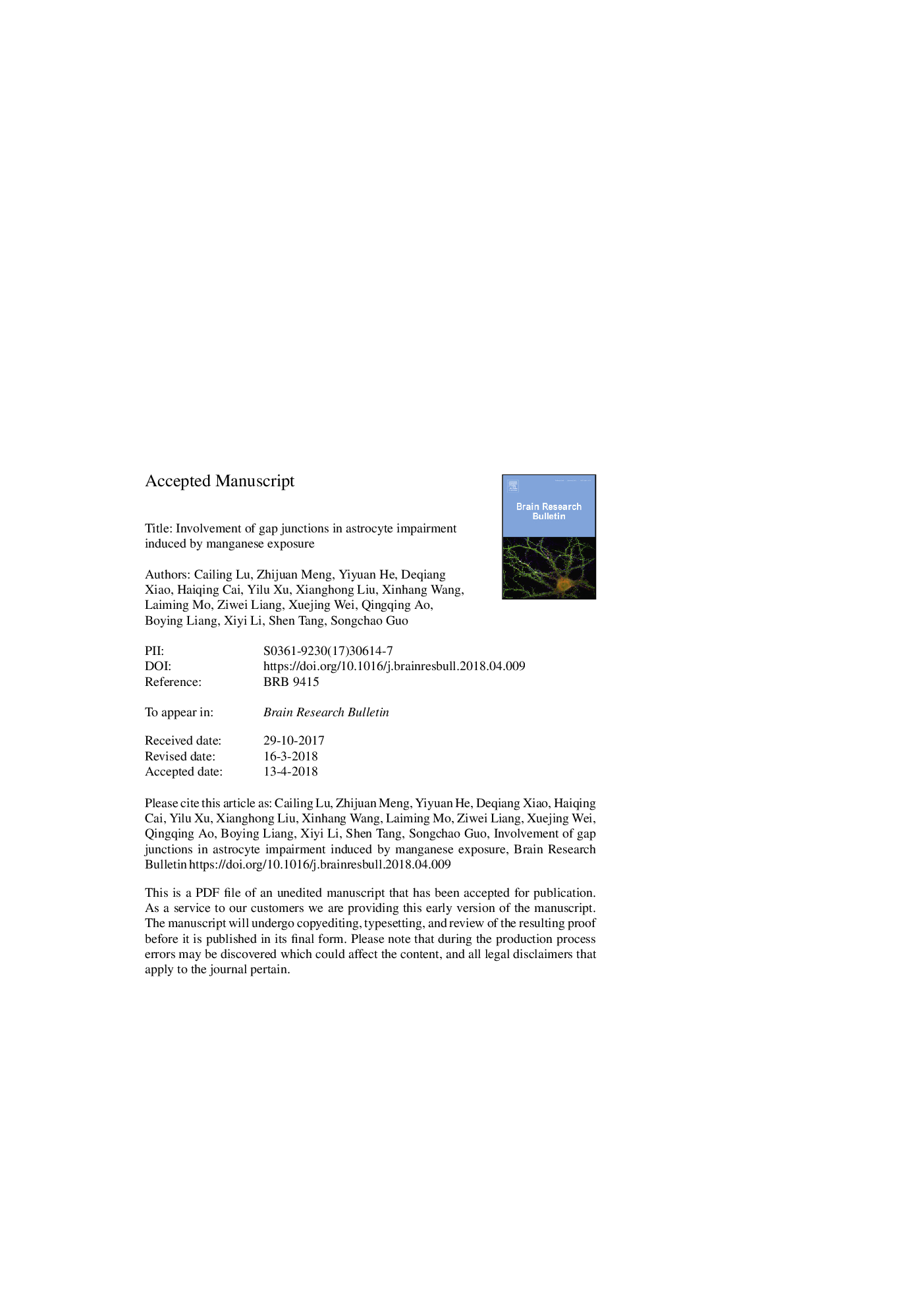| کد مقاله | کد نشریه | سال انتشار | مقاله انگلیسی | نسخه تمام متن |
|---|---|---|---|---|
| 8838852 | 1613217 | 2018 | 21 صفحه PDF | دانلود رایگان |
عنوان انگلیسی مقاله ISI
Involvement of gap junctions in astrocyte impairment induced by manganese exposure
ترجمه فارسی عنوان
درگیر شدن اختلاعات شکاف در آستروسیت ناشی از قرار گرفتن در معرض منگنز
دانلود مقاله + سفارش ترجمه
دانلود مقاله ISI انگلیسی
رایگان برای ایرانیان
کلمات کلیدی
موضوعات مرتبط
علوم زیستی و بیوفناوری
علم عصب شناسی
علوم اعصاب سلولی و مولکولی
چکیده انگلیسی
Glutamate excitotoxicity, characterized as excessive glutamate stress, is considered to be involved in cerebral ischaemia, brain trauma, and neurodegenerative diseases such as Parkinson's disease and Alzheimer's disease. Glutamate homeostasis disruption was highlighted in Mn neurotoxicity caused by high levels of Mn. Astrocytes, accounting for approximately 50% of the neuronal cells in the central nervous system and maintain glutamate homeostasis, are sensitive to neurotoxicity induced by Mn exposure. Astrocytes are tightly coupled with gap junctions (GJ), which are comprised of connexins, mainly connexin43 (Cx43). The gap junctional intercellular communication (GJIC) pathway allows small signal molecules, such as glutamate, ATP (adenosine triphosphate, ATP) and tropic factors, etc., to transfer between adjacent cells. Evidence has shown that astrocytes execute the bystander effect during cell death through the GJIC pathway. However, the pathogenic mechanism of the gap junction underlying glutamate neurotoxicity induced by manganese exposure has not been elucidated yet. In the present study, primary astrocytes were cultured and then exposed to different levels of Mn (ranging from 0 to 1000â¯Î¼M) for 4/16â¯h to investigate the function of the GJIC in apoptosis induced by Mn. The cellular toxicity was confirmed by cell viability and apoptotic percentage through MTT assay and flow cytometry (FC). The levels of intracellular/extracellular glutamate were measured by high-performance liquid chromatography (HPLC). The fluorescent dye, Lucifer Yellow (LY), was used to assess the status of gap junctions among astrocytes after Mn exposure. The protein/gene expression of major gap junctional forming protein, Cx43, was also investigated. Cell viability was distinctly reduced when exposed to 500 and 1000â¯Î¼M MnCl2 compared with control cells at both time points. The percentage of apoptosis was significantly increased among all detected Mn levels (125, 500 and 1000â¯Î¼M MnCl2) of exposure (pâ¯<â¯0.05) with a concentration-dependent manner at either time point. Mn administration for 4/16â¯h also caused a remarkable intracellular/extracellular glutamate increase in a concentration-dependent manner for extracellular glutamate levels (pâ¯<â¯0.01). Gap junctions were prominently inhibited by Mn with Cx43 protein shown as shortening of the LY dye transfer distance at both time points. In-cell western blot indicated that Mn caused a decrease in Cx43 protein/gene expression in a dose-dependent manner. These results suggested that the gap junction intercellular communication and its forming protein, Cx43, are likely involved in glutamate excitotoxicity induced by Mn exposure.
ناشر
Database: Elsevier - ScienceDirect (ساینس دایرکت)
Journal: Brain Research Bulletin - Volume 140, June 2018, Pages 107-113
Journal: Brain Research Bulletin - Volume 140, June 2018, Pages 107-113
نویسندگان
Cailing Lu, Zhijuan Meng, Yiyuan He, Deqiang Xiao, Haiqing Cai, Yilu Xu, Xianghong Liu, Xinhang Wang, Laiming Mo, Ziwei Liang, Xuejing Wei, Qingqing Ao, Boying Liang, Xiyi Li, Shen Tang, Songchao Guo,
